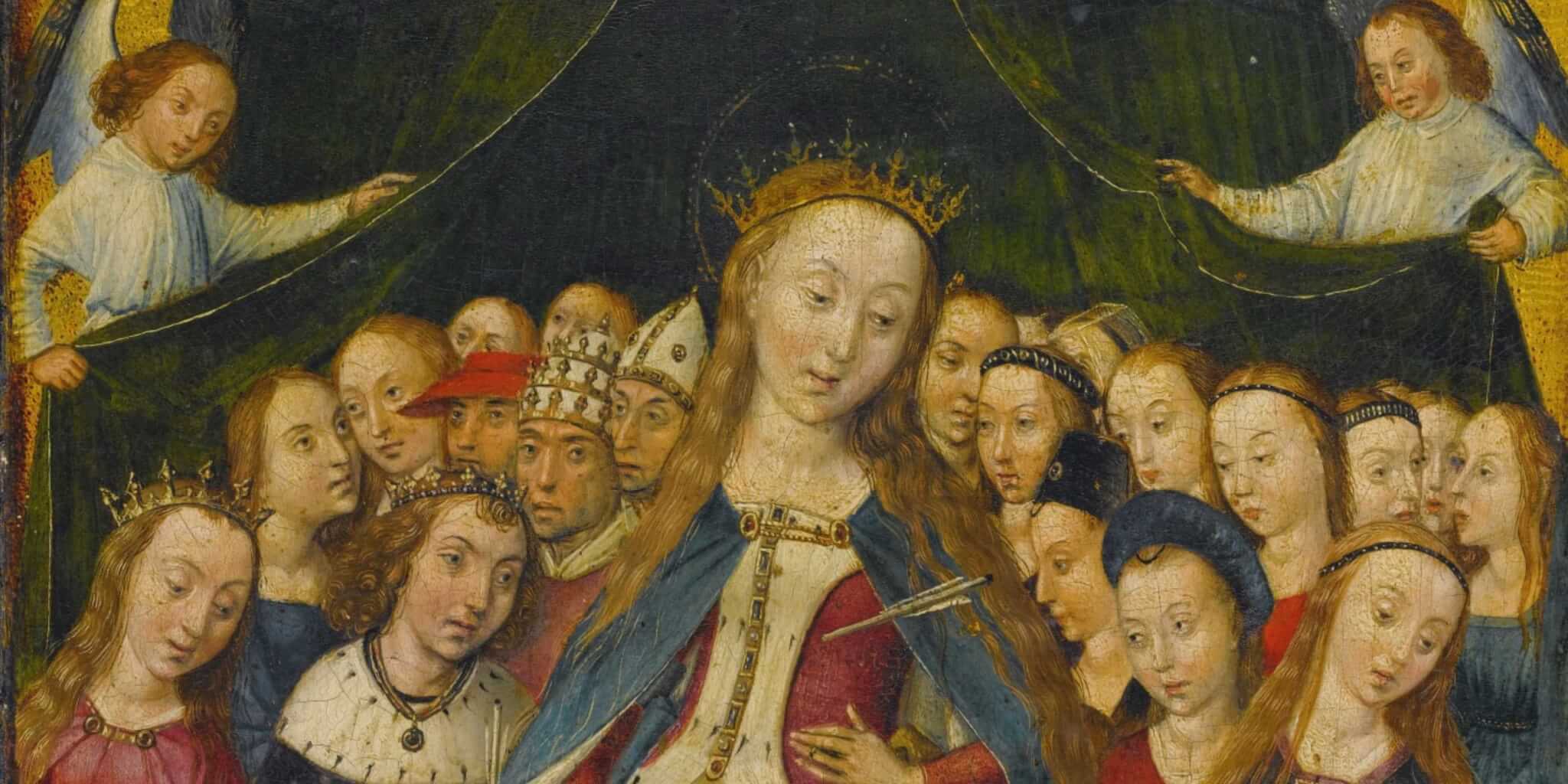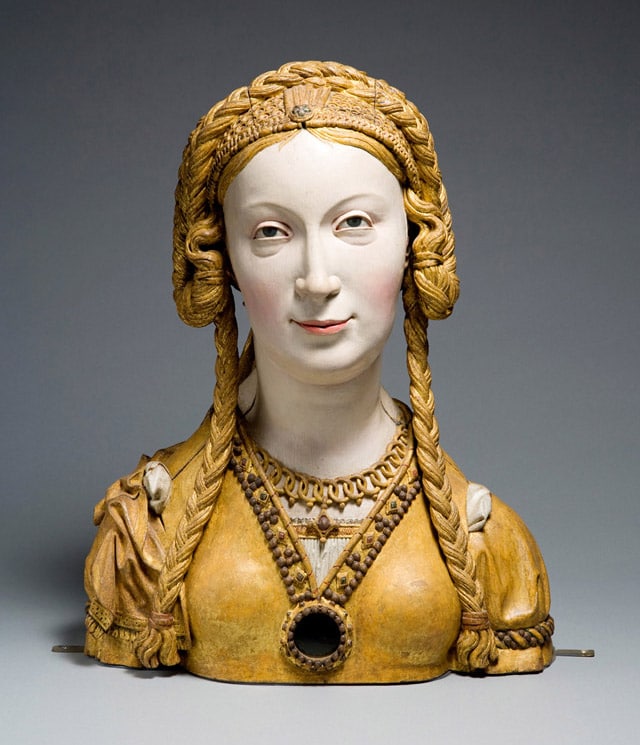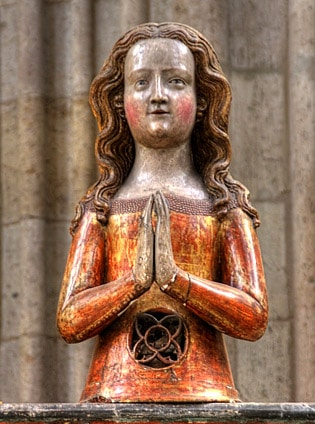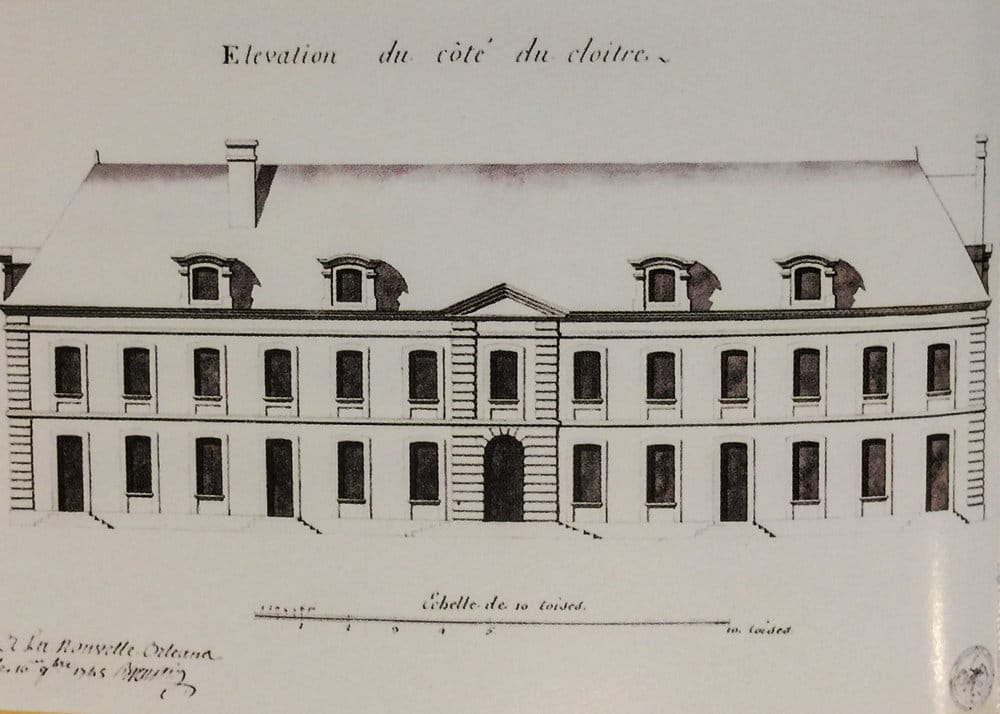-
 play_arrow
play_arrow
The CRUSADE Radio Network CRUSADE Radio Network
-
 play_arrow
play_arrow
PREVIEW: Bongino and Patel Detail Progress Mike "The KingDude" Church
-
 play_arrow
play_arrow
Audio Post Format TheKingDude
The Magnificent Story of Saint Ursula And The 11,000 Virgin Martyrs

The Magnificent Story of Saint Ursula
Written By Mike Church. Special thanks to Gretchen Filz for her The Story of St. Ursula the Warrior Princess and her 11,000 Companions
Mandeville, LA, 21 October, 2017 – The legend of Saint Ursula is one shrouded in mystery, uncertain facts and yet thrilling holiness. The old legend says that Ursula made a pilgrimage to Rome accompanied by 11,000 virgin companions.
the charitable objects of your institution [Saint Ursuline] cannot be indifferent to any; and it’s furtherance of the wholesome purposes of society, by training up it’s younger members in the way they should go, cannot fail to ensure it the patronage of the government it is under. be assured it will meet all the protection which my office can give it.
I salute you, holy sisters, with friendship & respect.
Th: Jefferson
Read More of Mike Church’s Thrilling Stories of Saints And Chivalry!
On their way back to England they were surrounded by barbarian Huns and when they refused to succumb to sexual favors, were massacred one by one. The mere thought of a field in Cologne Germany filled with the corpses of 11,000 is one the most heretical Satanist making millions in Hollywood can’t imagine but when considered as a miracle for the pre-Christian world to be inspired by it makes religious sense. Brother André Marie comments on Saint Ursula.
In the year 383, Saint Ursula and her 11,010 companions were all slaughtered for their purity and their Faith. This great martyrdom occurred in Cologne, in Germany. A shrine has been erected to them there, containing as many of their bones as could be rescued. A Religious Order of nuns in the Catholic Church in honor of Saint Ursula was established by Saint Angela Merici in the year 1535. They are known as the Ursulines.

The Catholic encyclopedia New Advent dismisses the cult and the story of Saint Ursula as a myth that might have some basis in the life of someone named Ursula who may or may not have lived:
[T]he martyrdom of St. Ursula is placed in the third, fourth, or fifth century. In order to account for all the details, two massacres of virgins at Cologne have been accepted, one in the third century, the other in the fifth. The different solutions with their variations suggested by scholars, sometimes with levity, sometimes with considerable learning, all share the important defect of being based on relatively late documents, unauthoritative and disfigured by manifest fables.
No conclusion can be drawn from these texts. Nevertheless, the fables they contain are insignificant in comparison with those which were invented and propagated later. As they are now unhesitatingly rejected by everyone, it suffices to treat them briefly. In the twelfth century there were discovered in the Ager Ursulanus at Cologne, some distance from the Church of St. Ursula, skeletons not only of women, but of little children, and even of men, and with them inscriptions which it is impossible not to recognize as gross forgeries.
The Basilica known as Saint Ursula in Cologne dates to the early Christian period of the 4th century. The church was rebuilt in the 10th century and excavations revealed a mass grave filled with ancient bones. The authenticity of the bones is noted by the church’s own history as using the storage of them as holy relics….
The discovery of more and more bones on the ‘ager Ursulanus’ during the following centuries secured the financial well-being of the female convent that had been established there around 922.
There is a new book just released in 2016 The Cult of St Ursula and the 11,000 Virgins edited by Professor Jane Cartwright. In the book Cartwright examines the cult of Saint Ursula and finds enough evidence in the cult that Wales now claims Ursula as their patron saint and also as a princess of that country that was conquered by England in 1283.
My hometown of New Orleans plays a key, modern role, in the Cult of Saint Ursula as the oldest surviving structure in the entire state (possibly the whole Louisiana Territory) is the Convent of Saint Ursuline in New Orleans French Quarter!
The Convent facing the river was completed. On July 17, 1734, the nuns, accompanied by a large group of notables and citizens, processed solemnly to their new quarters in the city’s first Eucharistic procession. For almost two decades, the convent was the Ursulines’ home and the center of their ministry at the hospital and their school.
Plans for the present day building are drafted. Authorized by Louis XV, the new convent was based on French models, but reflected a new colonial architecture adapted for elements, available material and human needs.
The Convent of the Ursulines was also home to New Orleans first school for girls The Ursuline Academy. In 1804, President Thomas Jefferson enters our story as Sister Therese de Xavier had written him after the Louisiana Purchase, concerned for the welfare of her school, sisters and convent. The notoriously unrepentant, anti-Catholic, Jefferson was positively sanguine in his return letter dated 13 July, 1804.
To the Soeur Therese de St. Xavier farjon Superior, and the Nuns of the order of St. Ursula at New Orleans,
I have recieved [sic], holy sisters, the letter you have written me wherein you express anxiety for the property vested in your institution by the former governments of Louisiana. the principles of the constitution and government of the United states are a sure guarantee to you that it will be preserved to you sacred and inviolate, and that your institution will be permitted to govern itself according to it’s own voluntary rules, without interference from the civil authority. whatever diversity of shade may appear in the religious opinions of our fellow citizens, the charitable objects of your institution cannot be indifferent to any; and it’s furtherance of the wholesome purposes of society, by training up it’s younger members in the way they should go, cannot fail to ensure it the patronage of the government it is under. be assured it will meet all the protection which my office can give it.
I salute you, holy sisters, with friendship & respect.
Th: Jefferson [emphasis mine – MC]
But the most convincing and magnificent of all the artifacts, relics and legends are the transcribed visions of Blessed Anne Catherine Emmerich (full disclosure: I have a devotion to Blessed Anne Catherine Emmerich). Composed around 1833, Emmerich’s visions are actually supported by the historical record in art. Her detailed description of Saint Ursula’s virgin martyr companions is identical to a 16th century bust of one of the martyrs down to the color of hair and makeup.

I am reproducing Blessed Anne Catherine Emmerich’s vision of the life of Saint Ursula, it is worth reading in its entirety. Saint Ursula, oremus (pray for us).
LIFE OF ANNE CATHERINE EMMERICH, Volume II
Saint Ursula
“Ursula and her companions were massacred by the Huns, about the year 450, near Cologne and in other places. Ursula was raised up by God to preserve the maidens and widows of her time from seduction and dishonor, and to enroll them in the celestial army of crowned martyrs. She accomplished her mission with extraordinary energy and constancy.
The archangel Raphael was given her as a guide. He announced to her her task, saying that the mercy of God willed not that, at this frightful epoch of destruction, so many virgins and widows left defenseless and deprived of protectors by the bloody wars should fall a prey to the savage Huns ; rather should they die as innocent children than live to fall into sin.
Ursula was not exactly beautiful; she was tall and strong, resolute and energetic, of a very grave countenance and masculine bearing. She was, at the time of her martyrdom, thirty-three years old. I saw her as a little girl in the house of her parents, Deonotus and Geruma, in a city of England. The house stood on a broad street; it had steps before the door, and a metal railing with yellow knobs. It looked like the paternal house of St. Benedict, in Italy, which too had brass railings surmounting a low wall.
Ursula had ten playmates who joined her every morning and evening in an enclosed field where, divided into two bands, they exercised in running, wrestling, and even in the use of the lance.
They were not all Christians, though Ursula and her parents were. Ursula was the instructress of her companions, and she exercised them thus by order of her angel. Her parents often watched their games well-pleased. Maximian, a pagan, was then lord over England, and I am not now sure that he was not the husband of Ursula’s eldest sister, Ottilia. Ursula had vowed herself to God.
A warrior, powerful and renowned, requested of her father the privilege of witnessing the exercises of the maidens of whom he had heard so much. Though embarrassed by the request, Ursula’s father dared not refuse. He tried, at first, to put him off; but the man insisted until he gained his point. He was charmed with Ursula’s skill and beauty and at once, asked her in marriage, saying that her young companions should espouse his officers in a country beyond the sea not yet peopled. I thought of Bonaparte, who made matches for his officers. I saw the father’s deep affliction and the daughter’s fright when apprised of this offer which could not be declined.
Ursula went by night to the playground and besought God in earnest prayer. The archangel Raphael appeared to her, consoled her, and instructed her to request that each of her companions might be allowed to choose ten other maidens, and to demand a delay of three years in which to practice all sorts of naval combats and maneuvers. He exhorted her to confidence in God, who would not permit her vow of virginity to be violated.
In these three years she was, with God’s help, to convert her companions to Christianity. Ursula delivered these conditions to her father who, in turn, proposed them to the suitor. He accepted them. Ursula and her ten companions chose respectively ten other maidens, who became their pupils. The father had five small vessels fitted out for them, upon each of which were about twenty girls and also a few sailors to teach them how to manage the sails and fight at sea.

And now I saw them exercising daily, first in a river, then along the sea-shore. They sailed along quietly, gave one another chase, separated, leaped from ship to ship, etc. I often saw a crowd on the shore watching them, especially the father and suitor, the latter rejoicing in the prospect of soon having so valorous and skillful a wife; for he thought with such a one by his side, he would be able overcome every obstacle.
After awhile I saw the maidens practicing alone without the sailors, Bertrand, the confessor, and two other ecclesiastics being upon the vessels. Ursula had, by this time, converted all her maidens, among whom were some only twelve years old. They were baptized by the priests. Ursula’s courage and confidence in God increased every day. I saw them landing on small islands and practicing their naval exercises, all accompanied with prayer and the chanting of the psalms, all performed with great freedom and boldness. Ursula’s wonderful earnestness and courage are quite indescribable.
The maidens wore short dresses, descending a little below the knee; they were quite plain on the hips and had close-fitting bodies. Their feet were laced. Some had their hair uncovered and braided around the head, whilst others wore a sort of headdress with ends hanging behind. In their exercises they used light, blunt spears.
When the three years agreed upon drew to a close, I saw that the maidens were one heart and one soul.
When, having already taken leave of their parents, they were about to embark to go to their future husbands, I saw Ursula in prayer. A luminous figure stood before her bidding her trust all to God, the Lord, who would give them the martyr’s crown as His own brides, pure virgins; that she herself should propagate Christianity wherever the Lord would lead her; and that many virgins should through her be saved from dishonor and enter heaven adorned with the crown of martyrdom.
The angel ordered her also to proceed to Rome with part of her virgins. Ursula confided all this to her ten assistants whom it greatly encouraged. But as many of the others murmured against her because, having started for their nuptials as they thought, she now wanted them to be brides of Christ, Ursula went from ship to ship, reminding them of Abraham, of the sacrifice of his son, and of the miraculous help he had received from God. She told them that they, too, should receive similar strength to offer Him a pure and perfect sacrifice.
Then she ordered the cowardly to leave the vessels and return home; but all were encouraged by her words to remain faithful.
As they sailed from England under pretense of joining their destined husbands, a great storm arose which separated their vessels from those of their attendants, and drove them toward the Netherlands. They could make use of neither sails nor oars, and the sea miraculously arose as they neared the land. As soon as they disembarked, their dangers began. A savage nation tried to oppose their progress; but at Ursula’s words, the maidens were allowed to return unmolested to their ships. A city lay at the point at which they quitted the open sea to sail up the Rhine, and here they encountered great troubles; but Ursula spoke for all, answered all.
When violent hands were about to be laid on the virgins, they boldly flew to arms and received supernatural assistance which paralyzed their aggressors, rendered them powerless to harm them.
Many maidens, as also widows and their children joined them on their journey. Before reaching Cologne, they were more than once challenged, interrogated, and threatened by the barbarous tribes along the shores. It was Ursula who always responded, and who urged her companions to ply their oars.
They arrived safe at Cologne where they found a Christian community and a little church. Here they sojourned for a time. The widows who had joined them on the journey and many young girls remained behind when Ursula proceeded further on her way.
Before setting out, however, she earnestly exhorted them to martyrdom as Christian matrons and virgins, rather than suffer violence from the pagan barbarians. They scattered throughout the surrounding district, spreading everywhere the teachings and heroic spirit of Ursula, who had departed with five vessels.
On reaching Basle, some of her little company remained therewith the ships whilst she herself set out for Rome with about forty of her maidens, accompanied by the priests and guides. They went processionally like pilgrims, through wildernesses and mountainous districts, praying and chanting psalms.
Wherever they halted, Ursula spoke of the espousals with Jesus and of the pure, immaculate death of virgins. Everywhere were they joined by recruits, whilst some of their number remained behind to diffuse their own spirit among the people.
At Rome they visited the tombs of the martyrs and the different places sanctified by their death. As they were informed that their short dresses and freedom of demeanor attracted attention, they procured mantles. The Pope, Leo the Great, sent for Ursula who disclosed to him the secret of her mission, related her visions, and received his advice with humility and submission. He gave her his benediction and presented her with some relics. On their departure, they were joined by Bishop Cyriacus and two priests, one Peter of Egypt, and the other from St. Augustine’s birth-place, a nephew of the one who had bestowed lands on the saint for his monastery.
Reverence for the holy relics was their chief motive in following Ursula. She took with her to Cologne a relic of St. Peter which is still venerated as such, though none know whence it came; one of St. Paul; some hair of St. John the Evangelist, and a scrap of the garment he wore when cast into the boiling oil. On the return of the pilgrims to Basle, they were joined by so many recruits that eleven vessels were necessary to convey them to Cologne.
Meantime, the Huns had made an irruption into the country, bringing with them misery and confusion.
The story of Saint Ursula and her 11,000 companions
At some distance from the city, the angel Raphael appeared to Ursula in a vision, made known the approach of her martyr’s crown, and told her all that she was to do; among other things, that she was to oppose resistance until her little army had been duly prepared and baptized. This vision Ursula communicated to her assistants, and all turned their thoughts to God.
As they approached Cologne, they were saluted by the shouts and darts of the Huns; but they rowed vigorously and passed the city. They would not have disembarked at all in its vicinity, were it not that so many of their party were there awaiting their arrival. They landed, therefore, about a league and a half above Cologne and halted in a field between two thickets where they pitched a sort of camp. Here I saw those that had remained behind hurrying to join them with their recruits. Ursula and the priests addressed the different bands and prepared them for the struggle.
The Huns approached and their leaders accosted Ursula; they insisted on being allowed to choose among the maidens. The latter, however, courageously prepared to defend themselves, whilst some of the inhabitants of the city and the country around who had suffered from the Huns, and others who had become acquainted with the virgins that had remained in Cologne, joined the pious little army armed with poles, clubs, and whatever else they could find. This was what had been commanded Ursula by the angel, that time might be gained until all were prepared for martyrdom.
During the engagement, I saw Ursula running hither and thither, zealously exhorting the bands in the rear and ardently praying. The priests were everywhere busily baptizing, for numbers of pagan women and girls had come over to them. By the time all were prepared for death, the Huns had surrounded them on all sides. They now ceased defending themselves and gave themselves up to martyrdom, singing the praises of God.
The matyrdom story of St. Ursula
Then the Huns fell upon them and slew them with axe and spear. I saw a whole row of virgins fall at one time under the darts of the barbarians; among them was one named Editha, of whom we have a relic. Ursula herself fell pierced by a lance. Among the bodies that strewed the field of martyrdom there were, besides the British virgin great numbers of those that had joined them at various places, also the priests from Rome, some other men, and some of their enemies. Many more were massacred on board the ships.
Cordula was not among those who had accompanied Ursula to Rome. She remained at Cologne where many joined her. When the slaughter began, she hid at first through fear; but she afterward gave herself up with all her companions, requesting to be put to death. The Huns were eager to spare them; but they offered so sturdy a resistance that, after a long delay, they were placed in a line, bound together by the arms, and shot with arrows. They went joyfully singing and dancing to martyrdom as if to a marriage-feast.
Later on many others gave themselves up and were put to death in different parts of the country. Shortly after, the Huns withdrew from the district. The bodies of the virgins and other martyrs were soon after interred in an enclosed field near Cologne. Deep pits were dug and walled in, and there the bodies were devoutly laid in rows.The ships of the virgins were open, beautiful, and very light, with galleries around them from which floated little standards; they had masts and projecting sides. By the oars ran benches used both for seats and births. I have never seen vessels so well ordered.
About the time that Ursula left England, the saintly Bishops, Germain and Lupus, lived in France; the former visited St. Genevieve, in Paris. She was then about twelve years old. When he crossed over to England with Lupus to combat the heretics, he consoled the parents of Ursula and those of the other maidens. The Huns mostly went bare-legged; they had leathern thongs hanging around the lower part of their body, and wore wide jackets and long mantles. These last they often rolled up and carried on their shoulders.”
Written by: TheKingDude
catholic cologne germany magnificent story new orleans october 21 saint Ursula saints Thomas Jefferson ursuline academy virgin martyrs wales
Similar posts
Parrott Talk-Groomers Ruined Mother’s Day
PREVIEW OF TODAY'S PARROT TALK. FOR THE FULL EPISODE SUBSCRIBE ON ITUNES. Social media was full of men pretending to be mothers. These groomers shared pictures of their families, and created posts that celebrated their motherhood. Mike Parrott has a few examples of how these […]
Featured post
Latest posts

The War Power To Take Out Cartels: Letters of Marque & Reprisal-Mike’s 2014 LPAC Speech

Brad Birzer and Winston Elliott Discuss “A New Dark Age”

Trump Should Read Thomas Jefferson’s First Inaugural Speech

Kamala Harris: The Shape Of Modern Evil, A Halloween Commentary
Mike Church Show- Review of 2016 Al Smith Dinner That Invited Killary
Current show
Upcoming shows

Mike Church Show Afternoon Replay
If You Missed The Live! Morning Drive Version
5:00 pm - 8:00 pmMike Church Show Weekend Best Of
12:00 am - 11:59 pm
Condimentum Elit
11:40 pm - 11:55 pm
Chart
HERE IT GOES YOUR COPYRIGHT TEXT. CAN ALSO CONTAIN LINKS LIKE THIS







Post comments (0)